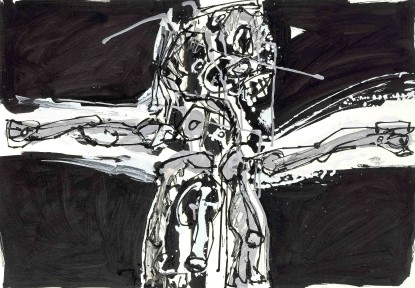Antonio Saura
Antonio Saura was born in Huesca in 1930 and died in Cuenca in 1998. He began painting and writing in 1947 in Madrid when, suffering from tuberculosis, he was laid up for five years. This was his first foray into art and pictorial experiments. He took Arp and Tanguy as influences, yet his work already stood out thanks to his highly personal style. He produced numerous dreamlike and Surrealist drawings and paintings that usually depict imaginary landscapes and employ a very colourful palette in flat, smooth applications of paint. He made his first stay in Paris in 1952. During his second stay in the French capital in 1954 and 1955, he met Benjamin Péret and was part of the Surrealist circle, although he and his friend and fellow painter Simon Hantaï soon left the movement. He was using the technique of grattage, or scraping, and had adopted a gestural style along with a radically abstract and always colourful handling the paint that was organic in conception and based on chance. At this time he worked by taking over the space of the canvas in several very distinct ways, creating formal structures that are highly personal and which he would continue to develop in the ensuing years. Forms now appeared that would soon become archetypes of women’s bodies or the human face. These two fundamental themes would come to dominate the greater part of his output.
In 1956 Saura embarked on a new range and level of work that would eventually form his major series, Ladies, Nudes, Self-portraits, Shrouds, and Crucifixions, executing these pieces on both canvas and paper. In 1957 in Madrid he founded the group El Paso, which he was to head until it broke up in 1960. He met Michel Tapié and had his first solo show at the Rodolphe Stadler Gallery (Paris), where he would regularly exhibit throughout his life. Stadler also introduced the painter to Otto van de Loo in Munich and Pierre Matisse in New York, both of whom were to represent Saura in the ensuing years. He chose to limit his palette to blacks, greys and browns, and asserted a personal style that was independent of the movements and trends marking his generation. His work followed in the tradition of Velázquez and Goya, and was soon hanging in the major museums. In 1959 Saura produced the first of a number of printed works; he indeed would prove quite a prolific printmaker over the years. He also illustrated numerous books in an original way, including Cervantes’s Don Quixote; Orwell’s 1984; Pinocho, Nöstlinger’s adaptation of the Pinocchio story; Kafka’s Tagebücher, Quevedo’s Trois visions; and many others.
In 1960, he started working in sculpture, creating pieces that feature welded metal elements depicting the human face, figures and crucifixions. In 1967 he settled permanently in Paris and joined the opposition to the Franco dictatorship, having a say in numerous debates and controversies in politics, aesthetics and artmaking over the years. He broadened his thematic and pictorial range. Along with the Femmefauteuils (or Womenarmchairs), Saura created series of works such as Imaginary Portraits, Goya’s Dogs and Goya’s Imaginary Portraits. In 1971 he stopped painting on canvas (he would take it up again in 1979) to concentrate on writing, drawing and painting on paper. In 1977 he began publishing his writings and was involved in creating stage designs for theatre, ballet and opera. In 1983 he produced a new and important series of portraits called Dora Maar or Dora Maar Visited. From that year until his premature death in 1998, Saura returned to all his earlier themes and figures, and brilliantly developed them anew, producing perhaps the best part of his large body of work.

SELECTED WORKS

Antonio Saura, DON 1.91, 1991
Oil on canvas
130 x 97 cm | 51.2 x 38.2 in

Antonio Saura, Crucifixión, 1960
Gouache and India in on paper
62,5 x 90 cm | 24.6 x 35.4 in

Antonio Saura, Autorretrato, 1966
Oil on canvas
161 x 130 cm | 63.4 x 51.2 in

Antonio Saura, Anat dans son Fauteuil, 1985
Oil on canvas
195 x 162 cm | 76.8 x 63.8 in